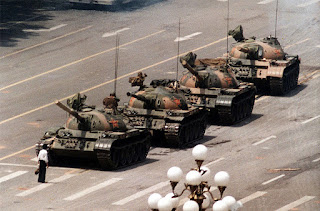How does a photograph become iconic? One word: Death.

Neda Agha-Soltan was a philosophy student in Tehran. Clandestinely, because it is against the law for Iranian women to do so, she studied singing. In what would be considered too-obvious symbolism were it to appear in a novel, her first name is Persian for "voice." Like most of us--and we mean no disrespect when we say this--she was a nobody. And then her life bled away on a Tehran street and on televisions and on computer screens and newspaper front pages around the world. Now she is "the voice of Iran."
The video brings to mind other iconic photographs. In its immediacy, it is evocative of perhaps the most famous war photograph of all time, Robert Capa's 1936 shot of a Republican militiaman apparently being shot in the head during the Spanish Civil War:
One cannot help but imagine what Capa thought. Right place, right time? When he set out for the front that day, he could not have expected to get that shot. Given the angle, Robert Capa himself must have been virtually in the line of fire. Did he know that he had captured history? Created history? Did he know his photograph would generate massive support for the Republican cause? How many men were inspired by this photograph to enlist? How many met a similar fate?
Consider another iconic moment of death, the shooting of a handcuffed Viet Cong prisoner in Saigon by General Nguyen Ngoc Loan in 1968 (photograph by Eddie Adams):

Does it matter that the prisoner himself was apparently a war criminal? No. This picture arguably marked the beginning of the American public's decisive turn away from the Vietnam War--a turn that perhaps became irreversible after the publication of another photograph, a modern Pieta:
Here, we know the victim's name. Like Neda Agha-Soltan, Jeffrey Miller was a student. He was one of four Kent State University students shot by National Guardsmen on May 4, 1970. We even know the name of the anguished young woman--girl, really--kneeling above Miller: Mary Ann Vecchio.
In confrontations with authority, students disproportionately bear the brunt:
Is this, too, an image of imminent death? We don't really know. There is speculation about what happened to "Tank Man"--the only name we have for him--after the protests in Tienanmen Square. Some say he still lives, very quietly, in China. Others believe he died during the protests or shortly thereafter. Somehow, this seems more likely.
At least Tank Man, unlike our other subjects, appears to be an agent of his own destiny. He clearly made a choice to confront authority; we like to think he was willing to martyr himself for his cause.
Was Jeffrey Miller willing to die for his cause? Maybe, but we can assume he didn't expect to. Neda Agha-Soltan wasn't even protesting when she was shot. She had gotten out of her car for a breath of fresh air when a bullet struck her. Maybe she and Miller will meet somewhere and compare notes.
One other thing that we can't help noticing: In this newest exhibit in the Gallery of Death, we literally watch Neda die. This is different. With those other icons, we saw a moment of death; with Neda, we get a narrative. We cannot help but wonder if she realized what was happening--not just that she was dying, but that her death was unimaginably public? Did she notice the videographer? As an apparently apolitical woman, would she find comfort in the fact that her death is inflicting massive, possibly irreparable damage on the Iranian clerical regime?
For her sake--and for ours--we hope so. Otherwise, this isn't history. It's a snuff film.
(Neda Agha-Soltan image from NYTimes.com; Robert Capa--Falling Soldier image from photo.net; Kent State shooting image from Forgotten Ohio: Kent State University; Vietcong prisoner image from Arkitektrue.com; Tienanmen Square image from Wikipedia)



Students do bear the brunt of protest, although perhaps that's because they're still willing to stand up for something.
ReplyDeleteHello friend. I've been absent these many weeks as my work life has been insane, but felt I wanted to pick up your blog as I had a few spare minutes. This post was one of your best, an astute commentary on the moments when a single death has swayed millions to oppose the horrors of current events. Well done!
ReplyDeleteYour bud!
N.